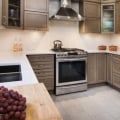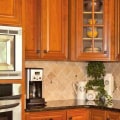When it comes to kitchen cabinets, there is no one-size-fits-all solution. The standard depth of wall-mounted kitchen cabinets is 12 inches, but some can go up to 24 inches deep. Base cabinets are typically around 24 inches deep, while wall cabinets are usually 12 inches deep, though they can also come in 15-, 18- and 24-inch varieties. It is possible to reduce the depth of cabinets to fit narrow aisles or specific dimensions, but this requires cutting the bottom, sides, top and shelf.
Upper cabinet heights range from 12-inch to 42-inch options, with shorter cabinets above refrigerators and stoves. When planning a kitchen remodeling project, it is important to consider the basic dimensions of your kitchen cabinet and create a larger plan that includes floor level measurements, the location of windows and doors, wiring, pipes and gas lines, as well as light switches and accessories. Full-height kitchen cabinets are available in standard depths (12, 24, 36 inches) (30, 61, 92 cm) and in different standard widths. In some cases, such as when a bench of upper cabinets is formed on a peninsula or island, the cabinets may be suspended from the ceiling or attached to protruding ceiling lamps.
When it comes to installing kitchen cabinets, the base cabinet is an essential building block. It is important to take into account the size of the appliance when installing wall cabinets above a refrigerator or stove. For example, wall cabinets designed to be installed above a refrigerator will be deeper so that the front of the cabinet is aligned with the front of the appliance. In many cases, for this type of appliance, it is necessary to remove two of the lower drawers of the upper cabinet of the oven to have the additional height necessary to install the appliance correctly inside the cabinet.
When choosing which cabinets to install, it is important to consider different kitchen styles that can make all the difference in the depth of your closet. To determine the correct height of wall cabinets above a range, compare the height of other wall cabinets. The heights of wall cabinets tend to be limited, as they must fit between the counter and ceiling. This means that anything from pantry cabinet to tall cabinet or corner cabinet does not take into account door size.
Some homeowners want ceiling moldings and display space above kitchen wall cabinets; others want them to reach directly to the ceiling so that everything is securely contained. Not being a professional can make ordering kitchen cabinets seem like rocket science. Here's a simple and comprehensive guide to help you find out which size is best for you. With this information in mind, you can easily add additional cabinets such as corner cabinets, tall cabinets and wall cabinets according to base sizes.


